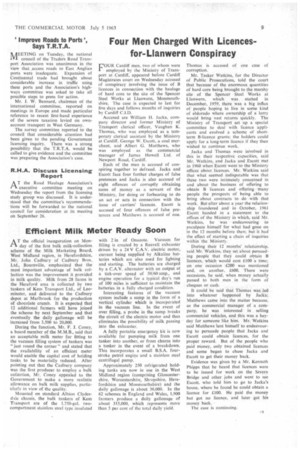Efficient Milk Meter Ready Soon
Page 11

If you've noticed an error in this article please click here to report it so we can fix it.
i‘ T the official inauguration on Monrl day of the first bulk milk-collection scheme of the Milk Marketing Board, West Midland region, in Herefordshire, Mr. John Cadbury of Cadbury Bros. Ltd., Bournville, emphasized that the most important advantage of bulk collection was the improvement it provided in milk quality. Milk from 28 farms in the Hereford area is collected by two tankers of Kern Transport Ltd., of Leominster, and delivered to the Cadbury depot at Marlbrook for the production of chocolate crumb. It is expected that 12 additional farmers will have joined the scheme by next September and that eventually the daily gallonage will be increased from 3,500 to 20,000.
During the function, Mr. F, J. Coney, a board member of the M.M.B., said that an acceptable milk meter for fitting to the vacuum filling system of tankers was "just round the corner" and stated that the availability of an efficient meter would enable the capital cost of holding tanks to be materially reduced. After pointing out that the Cadbury company was the first producer to employ a bulk collection, Mr. Coney appealed to the Government to make a more realistic allowance on bulk milk supplies, particularly in view of the quality.
Mounted on standard Albion Clydesdale chassis, the bulk tankers of Kern Transport are of the 1,750-gal. twocompartment stainless steel type insulated with 2 in of Onazote. Vacuum for filling is created by a Reavell exhauster driven by a 24 V C.A.V. electric motor, current being supplied by Alkaline batteries which arc also used for lighting and starting. The batteries are charged by a C.A.V. alternator with an output at a tick-over speed of 50/60 amp., and engine operation for a typical day's run of 100 miles is sufficient to maintain the batteries in a fully charged condition.
Interesting features of the vacuum system include a sump in the form of a vertical cylinder which is incorporated in the vacuum line. In the event of over filling, a probe in the sump breaks the circuit of the electric motor and thus eliminates the possibility of milk passing into the exhauster.
A fully portable emergency kit is now available for pumping milk from one tanker into another, or from churns into a tanker in the event of a breakdown. This incorporates a small B.S.A. fourstroke petrol engine and a stainless steel centrifugal pump.
Approximately 250 refrigerated holding tanks are now in use in the West Midland region (comprising Gloucestershire, Worcestershire, Shropshire, Herefordshire and Monmouthshire) and the daily gallonage is about 36,000. In the 62 schemes in England and Wales, 1,900 farmers produce a daily gallonage of about 315,000, which represents more than 5 per cent of the total daily yield.












































































































